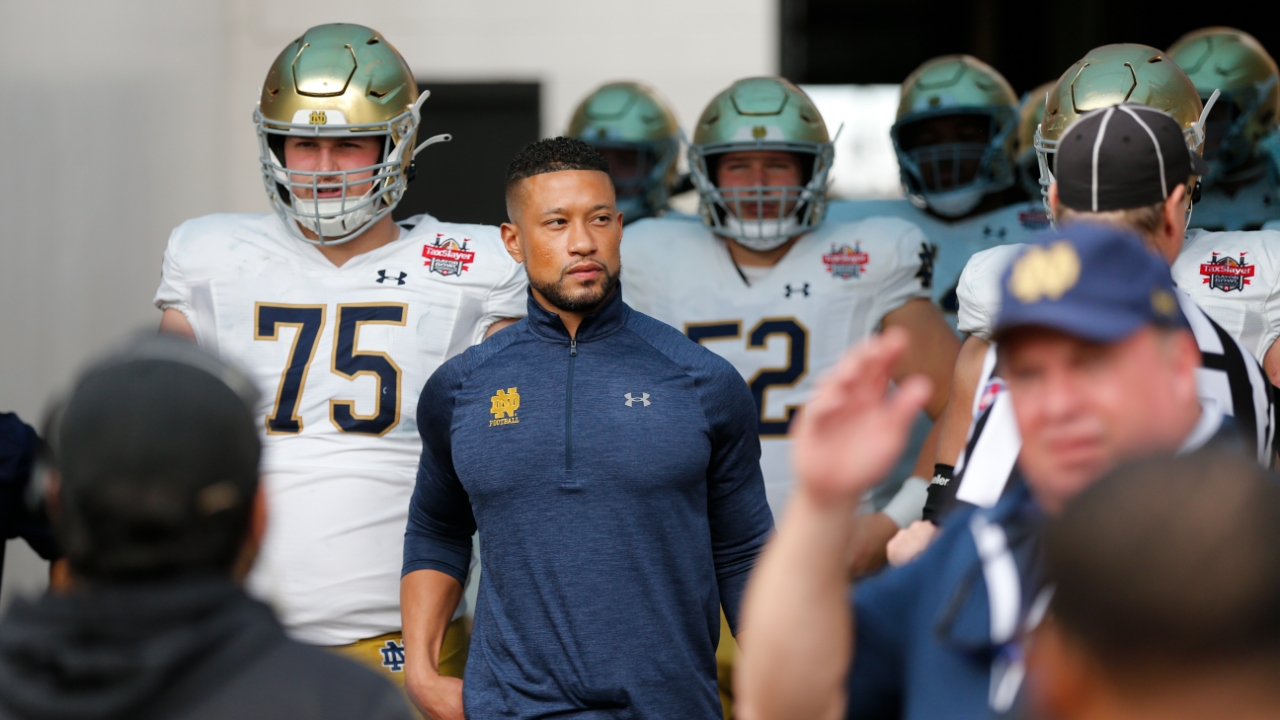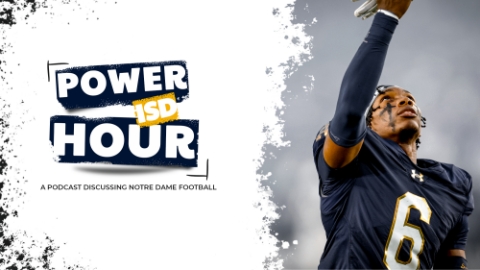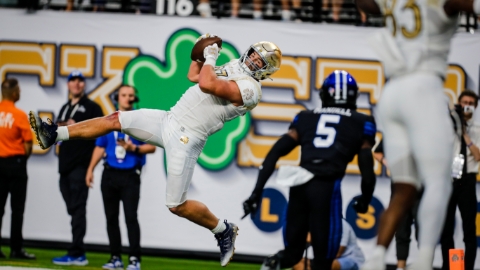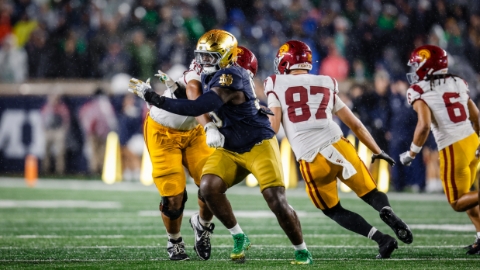
Cinderella teams still exist in college football. TCU is proof of that.
The problem is that Cinderella can get to the ball and maybe even get out of there with the prince looking for them at midnight. But when it comes time to put on the glass slipper, it doesn’t fit.
There are no happy endings for Cinderellas in modern day college football.
Georgia found that glass slipper on Monday night and repeatedly bashed TCU over the head with it. They showed that TCU was a nice story, but nothing more than that. They weren’t going to be a national champion.
In order to win a national championship in the College Football Playoff era, a program needs to check a lot of boxes.
They need to recruit at an elite level.
They need to have multiple first round picks on their roster.
They need to have NFL talent at receiver and defensive line.
They need to have one of the best offensive lines in the country.
They need to be great on offense and defense.
They need to create negative plays on defense.
They need to have an explosive passing game.
Not checking one of these boxes isn’t going to eliminate a team from contention. Not checking two is a problem that has to be overcome. Not checking any more than that in the last six seasons means they have no shot.
TCU doesn’t recruit at an elite level, they don’t have enough NFL talent, they don’t have one of the best offensive lines in the country, they aren’t great on defense and their Havoc rate isn’t good enough. That was going to be way too much to overcome against a Georgia team that only lacks the top-end receiver talent of most champions (they make up for it at tight end).
I looked at every national champion since the start of the CFP after the 2014 season to see what seprated them from the pack. They had a lot in common.
Top-8 in OF+
OF+ is the combined offensive rating for FEI and SP+. Each national champion since 2014 (Ohio State, LSU, Clemson twice, Georgia twice, Alabama thrice) has been ranked in the top-8 on offense in OF+ with one lone exception: Alabama in 2015.
They were 22nd.
Great offense wins championships. The last five national champions have finished 5th, 1st, 1st, 3rd, and 4th in OF+.
This is an area where Notre Dame frankly hasn’t been good enough to field a championship team. The only time they’ve finished in the top-8 during the CFP era was 2015 (6th).
This is why it’s significant to add Sam Hartman at quarterback, who helped Wake Forest finish 12th in back to back seasons. Good needs to become great on offense.
Last year with Drew Pyne at quarterback and a very young wide receiver group, the Irish finished 41st in OF+. Prior to that they hovered around the top-20.
Top-15 in DF+
This is the same combined rating for defense. Every single national champion since ‘14 has had a top-15 defense. All of them were in the top-8 with Ohio State (15th) and LSU (14th) being the only exceptions.
Notre Dame has had a top-15 defense three times in the last five seasons (2018, 2019, and 2021). If they paired that up with an offense like they had in 2015, then they’d be cooking with some grease. The problem is that they haven’t been higher than 13th with above average offenses those seasons.
Top-15 in explosive passing plays (receptions of 20+ yards)
This has become more obvious in the last five seasons with Clemson, LSU, Alabama, and Georgia. Big plays in the passing game matter. A lot.
The only two champions who weren’t in the top-15 were Alabama in ‘15 and ‘17 and Nick Saban recognized where the game was evolving after that. That’s how they went from being a ground and pound program to having one of the best passing offenses in the nation with a heavy RPO influence.
Notre Dame finished in the top-15 in explosive passing plays in 2014 (7th) and 2019 (13th). It’s not a coincidence that they had two elite receiver seasons with Will Fuller and Chase Claypool. (More on that in a bit)
Multiple first round picks on the roster
Do you have “dudes”? Every team who won the natty recently has checked that box with multiple future first round picks on the roster.
Ohio State didn’t have one directly after they won the championship, but had five key pieces on that team who went in round one the next NFL Draft. Alabama only had one after their championship in ‘17, but five went in the second round in that draft and they had eight who eventually became first round picks who played on that team.
It’s not just two first rounders either, but Notre Dame has had only two years where they had two (2015 and 2017). They possibly could have two more in this upcoming draft.
Day one or day two picks at WR and TE
Every single team has had top end talent at wide receiver or tight end. Georgia might not have had the receivers this year, but they have Brock Bowers and Darnell Washington who both project to be high picks at tight end. It’s probably unnecessary to go over the lists for each of these teams and list every single who was drafted in rounds 1-3 by an NFL team, but every Notre Dame fan knows that this is an area where the Irish need to catch up in a significant way.
Brian Kelly gave interviews about having Will Fuller and Michael Floyd on the same team. He never did enough to make that kind of thing happen.
Will Fuller, Miles Boykin, Chase Claypool, Cole Kmet, and Michael Mayer are the names for Notre Dame who were and will be taken on day one or day two. For some of these teams, that’s the kind of talent on the roster all at the same time.
NFL talent on the defensive line
Every single champion has had at least three future NFL Draft picks playing on their defensive line.
Notre Dame had this kind of talent. They had five future picks in the 2018 defensive line rotation, three in 2019, and three in 2020. The problem is that they haven’t recruited to a level that has kept that kind of talent every year since and the defensive line isn’t a position where 3-stars routinely end up being developed into NFL Draft picks.
Joe Moore Award semi-finalists
The only O-line for a national champion who didn’t get selected as a semi-finalist as one of the best groups in college football? That would be the 2016 Clemson O-line. They are the lone exception and out of the eight champions since they started giving out the award in 2015, five of them have had O-lines finish as finalists.
Notre Dame has finished as a finalist three times and they should be a semi-finalist every at the very least every season. This is one area where Notre Dame should always be one of the leaders.
Hitting the mark on net points per drive
Brian Fremeau, the creator of the FEI ratings for college football, tracks net points per drive every season and it’s the difference between points scored per offensive drive and points given up per defensive drive.
No champion has finished below 1.37 (Clemson in 2016) and teams are becoming more dominant. Every champion has been at 2.28 net points per drive or more in the last five years.
Notre Dame’s best finish in net points per drive was 1.53 in 2019.
The best teams dominate. It’s as simple as that.
A minimum rate of havoc
ISD readers know that I’m a big believer in Havoc rate (tackles for loss, pass breakups, interceptions, and forced fumbles divided by the number of snaps on defense) and it’s not just because it sounds cool.
The teams who create more negative plays on defense win more games. Champions have elite Havoc rate.
This year’s Georgia team, which lost a ton of talent to the NFL after last season, had the lowest rate of any champion in the CFP era at 17.1%. No other champion had a rate below 18.6%. All of the rest were above 19.5% and finished in the top-15 in the country.
The Havoc rate for the Irish, though improved in the second half of the season, wasn’t close to good enough for Notre Dame last season. 14% is far from where they need to be. The only time Notre Dame finished with a top-15 Havoc rate was in 2020 (20.8%).
They need to make more plays on defense.
Blue-chip ratio
Blue-chip ratio was created by Bud Elliott, previously of SB Nation and currently of 247Sports. It’s the percentage of blue-chip recruits (4 and 5-stars) that a program signs over a four year period. Since he’s been tracking it, every team who has won a championship has had at least a 50% BCR.
In the CFP era, every team but one, Clemson 2016 is once again the outlier, had a BCR of at least 61%.
The good news is that Notre Dame’s BCR for next season is going to be the highest it’s been since 2015. Off of the strength of two strong recruiting classes in a row, they’ll be at 67.8% in 2023. They signed more than double the amount of blue-chips in the ‘22 and ‘23 cycle than they did in the final two recruiting classes put together by Brian Kelly.
That doesn’t mean they are going to be as talented as the 2015 team because most of the blue-chips are going to be freshmen and sophomores as opposed to the juniors and seniors that led that team. It should mean that the infusion of talent should help Notre Dame make their way to being elite on both sides of the ball.
It should mean more plays being made (ie havoc) from the defense. It should mean more explosive plays on offense. It should mean more NFL talent with plenty of individuals becoming high picks in the years to come.
It was clear last night that Georgia is in that championship tier and TCU is not. Notre Dame is there with TCU right now and if they want to join Georgia, Alabama, Ohio State, LSU, and Clemson as champions in the CFP era, they have to start checking all of these boxes.
Men's Colosseum Charcoal/Navy Notre Dame Fighting Irish Good On You Raglan Full-Zip Jacket



